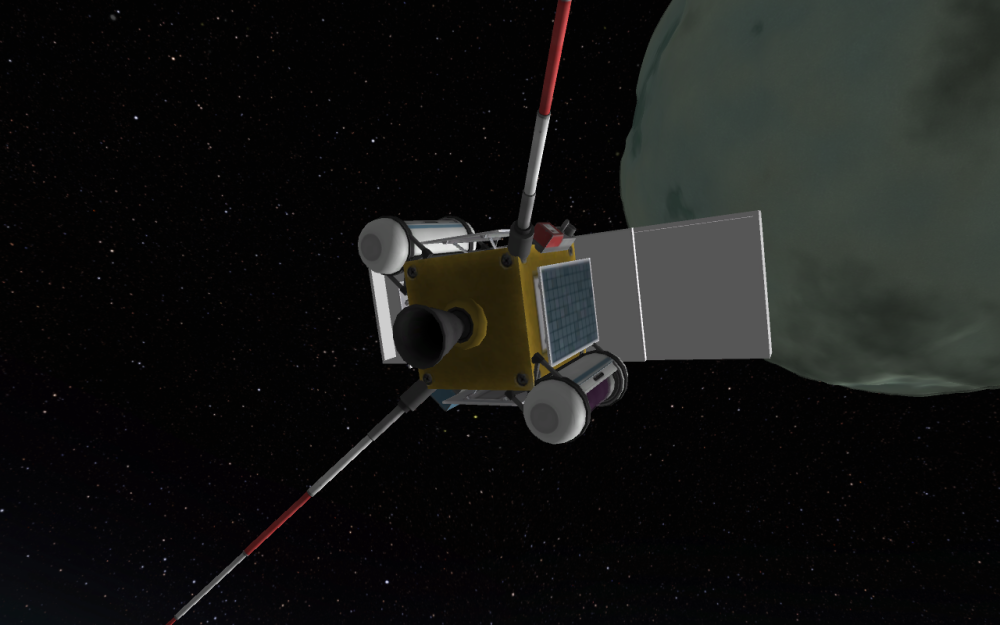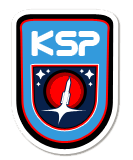Aries IV goes orbital
A modified Arrow III stood proudly on the launchpad. By now all had been able to guess Jeb’s reason to push the development forward of this booster. Oddly it lacked its typical side boosters, but Bill had done the calculations and it should be enough.
The rocket took off without a hitch (note the retracting service arms!) and despite the fact that KSC would not certify a solid-fuel rocket for Kerbal flight, it made a perfect vehicle for unmanned stages. Jeb had now scored several successful launches with his Arrow serries which made him an attractive partner for commercial traffic.
Today’s payload was the Aries IV. Its main computers were still undergoing changes so guidance was done from the satellite bus that came with the Arrow. The sensors registered heavy vibrations and quite a few G’s when the rocket went up, but trajectory looked good and without any trouble, the payload got pushed into a 438x136km orbit.
Engineers performed all kinds of tests. In particular the deployment of the solar panels, re-entry alignment, power and navigation systems. After two orbits the engine lit up again and dropped the capsule in the deserts of Kerbia. Recovery would only happen after 2 days search. “Need better recovery procedures.” Gene wrote down.
Two weeks later the next Aries stood ready. This time on top of a Wodan 011B2. The 2 at the end indicated the number of boosters. This time the rocket had a reduced capacity, which was still too much but they had still not fixed the thrust issue on the first stage so the additional engines were needed for liftoff.
To compensate KSA added 2 satellites as a secondary payload. CubeSat 1 and 2 were going to investigate Bob’s claim to the gravioli beams and map the surface of the Mun and Minmus.
A flawless take off, and soon the payload was placed in a 200x208km high orbit. Which would prove difficult to deorbit. The upper stage also released two small satellites and deorbited itself, after borrowing some power from the sats. “Need more battery,” Korolev noted in her report.
The secondary payloads blasted off to Minmus and the Mun. Then KSC started powering up the systems on the Aries and ran a series of tests. With environmental controls running at normal the spacecraft would be kept in orbit for 9 days before the deorbit.
Well before that time, CubeSat A2 came into the orbit of the Mun and confirmed Bob’s theory and started mapping the surface.
After 9 days the Aries V reoriented itself and started a decent burn. Just before it hit the atmosphere, the service module got separated and the heatshield was turned retrograde. This is where the problems started. Within 30 seconds all ablator burned up and the remainder of the heat got transferred to the structural frame. Fortunately, the Aries was designed to take the heat and internal temperature stayed within parameters.
While Kerbol was setting on Kerbia, the Aries V landed safely in the desert and activated its homing beacon.
This time the recovery crew quickly found its way. Flying a brand new CH-200A Hippo helicopter, Valentia, Korolev, Bill and Jeb located the craft very quickly. After preliminary checks, they radioed in the land recovery crew which arrived before the night was over.
The capsule was then loaded on the newly V118A Crane. It took some fiddling but they managed to secure to load using the newly developed EVA struts. While the main crew flew back the trailer started its long journey to the airport and finally to KSC.
There the heatshield was delivery to the VAB and the capsule was then deposited at KSA research center for further analysis, but all in all the mission was already a great success and the Aries had proved itself fit for orbital duty.

Two days later the final payload arrived at Minmus and started its science mission.































